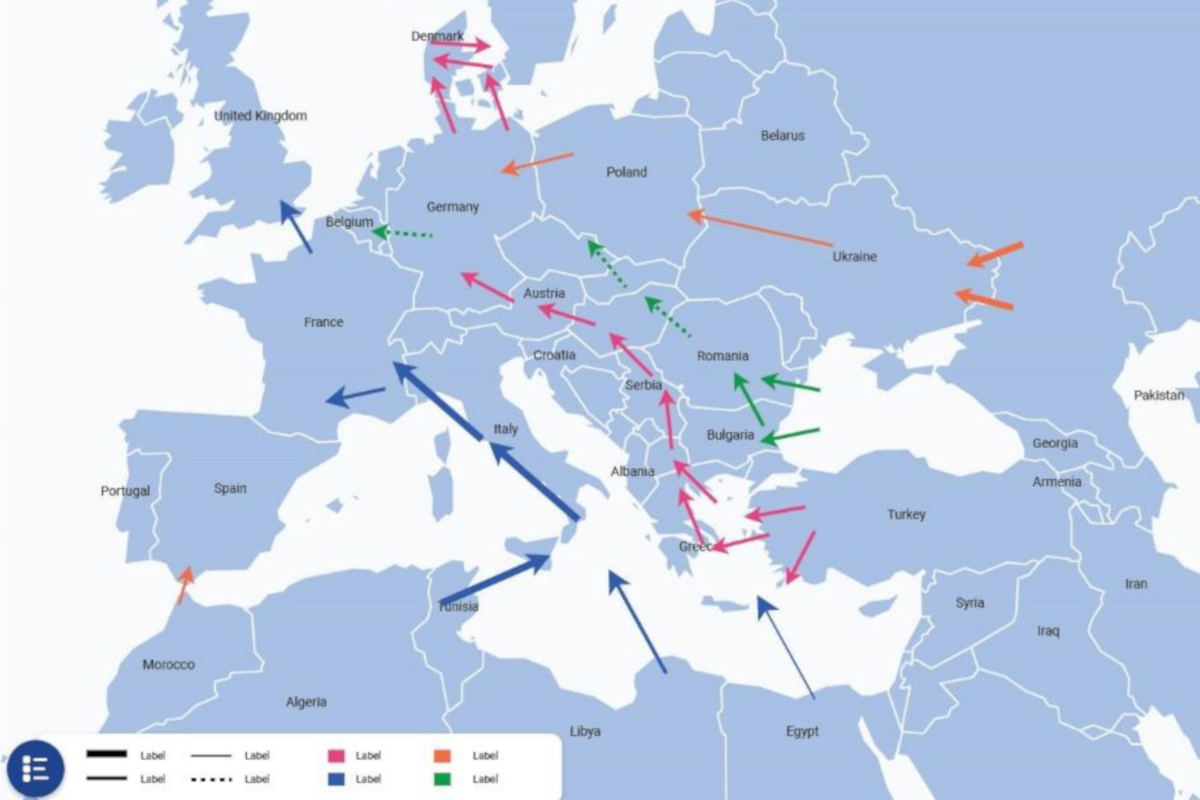Joint statement: The EU Artifical Intelligence Act must protect people on the move
Topic
Country/Region
06 December 2022
Joint statement signed by over 160 organisations and 29 individuals, in the run-up to votes in the European Parliament on the position to be taken in negotiations with the Council of the EU.
Support our work: become a Friend of Statewatch from as little as £1/€1 per month.

Image: WARDJet, CC BY-SA 2.0
See also: a blog post by EDRi explaining the need for changes to the AI Act, and: EU has spent over €340 million on border AI technology that new law fails to regulate (Statewatch, May 2022)
The European Union Artificial Intelligence Act (AI Act) will regulate the development and use of ‘high-risk’ AI, and aims to promote the uptake of ‘trustworthy AI’ whilst protecting the rights of people affected by AI systems.
The European Union Artificial Intelligence Act (AI Act) will regulate the development and use of ‘high-risk’ AI, and aims to promote the uptake of ‘trustworthy AI’ whilst protecting the rights of people affected by AI systems.
However, in its original proposal, the EU AI Act does not adequately address and prevent the harms stemming from the use of AI in the migration context. Whilst states and institutions often promote AI in terms of benefits for wider society, for marginalised communities, and people on the move (namely migrants, asylum seekers and refugees), AI technologies fit into wider systems of over-surveillance, criminalisation, structural discrimination and violence.
It is critical that the EU AI Act protects all people from harmful uses of AI systems, regardless of their migration status. We, the undersigned organisations and individuals, call on the European Parliament, the European Commission, the Council of the European Union, and EU Member States to ensure the EU Artificial Intelligence Act protects the rights of all people, including people on the move. We recommend the following amendments to the AI act:
1. Prohibit unacceptable uses of AI systems in the context of migration
Some AI systems pose an ‘unacceptable risk’ to our fundamental rights, which will never be fixed by technical means or procedural safeguards. Whilst the proposed AI Act prohibits some uses of AI, it does not prevent some of the most harmful uses of AI in migration and border control, despite the potential for irreversible harm.
The AI Act must be amended to include the following as ‘prohibited practices’:
- Predictive analytic systems when used to interdict, curtail and prevent migration. These systems generate predictions as to where there is a risk of “irregular migration” and are potentially used to facilitate preventative responses to forbid or halt movement, often carried out by third countries enlisted as gatekeepers of Europe’s borders. These systems risk being used for punitive and abusive border control policies that prevent people from seeking asylum, expose them to a risk of refoulement, violate their rights to free movement and present risks to the right to life, liberty, and security of the person.
- Automated risk assessments and profiling systems. These systems involve the use of AI to assess whether people on the move present a ‘risk’ of unlawful activity or security threats. Such systems are inherently discriminatory, pre-judging people on the basis of factors outside of their control, or on discriminatory inferences based on their personal characteristics. Such practices therefore violate the right to equality and non-discrimination, the presumption of innocence and human dignity. They can also lead to unfair infringements on the rights to work, liberty (through unlawful detention), a fair trial, social protection, or health.
- Emotion recognition and biometric categorisation systems. Systems such as AI ‘lie-detectors’ are pseudo-scientific technology claiming to infer emotions on the basis of biometric data, while behavioral analytics are used to detect ‘suspicious’ individuals on the basis of the way they look. Their use reinforces a process of racialised suspicion towards people on the move, and can automate discriminatory assumptions.
- Remote Biometric Identification (RBI) at the borders and in and around detention facilities. A ban on remote biometric identification (such as the use of facial recognition) is required to prevent the dystopian scenario in which technologies are used to scan border areas as deterrence and part of a wider interdiction regime, preventing people from seeking asylum and undermining Member States’ obligations under international law, in particular upholding the right to non-refoulement.
2. Expand the list of high-risk systems used in migration
While the proposal already lists in Annex III the uses of ‘high-risk’ AI systems in migration and border control, it fails to capture all AI-based systems that affect people’s rights and that should be subject to oversight and transparency measures.
To ensure all AI systems used in migration are regulated, Annex III must be amended to include the following as ‘high-risk’:
- Biometric identification systems. Biometric identification systems (such as mobile fingerprint scanners) are increasingly used to perform identity checks, both at and within EU borders. These systems facilitate and increase the unlawful and harmful practice of racial profiling, with race, ethnicity or skin colour serving as a proxy for an individual’s migration status. Due to the severe risks of discrimination that come with the use of these systems, lawmakers must ensure the EU AI Act regulates their use.
- AI systems for border monitoring and surveillance. In the absence of safe and regular pathways to the EU territory, people will cross European borders via irregular means. Authorities increasingly use AI systems for generalised and indiscriminate surveillance at borders, such as scanning drones or thermal cameras. The use of these technologies can exacerbate violence at the borders and facilitate collective expulsions or illegal pushbacks. Given the elevated risks and broader structural injustices, lawmakers should include all AI systems used for border surveillance within the scope of the AI Act.
- Predictive analytic systems used in migration, asylum and border control. Systems used to generate predictions as to migration flows may have vast consequences for fundamental rights and access to international protection procedures. Often these systems influence how resources are assessed and allocated in the migration control and international protection contexts. Incorrect assessments about migration trends and reception needs will have significant consequences for the preparedness of Member States, but also for the likelihood that individuals can access international protection and numerous other fundamental rights. As such predictive systems should be considered as ‘high-risk’ when deployed in the context of migration.
3. Ensure the AI Act applies to all high-risk systems in migration, including those in use as part of EU IT systems
Article 83 of the AI Act lays out the rules for AI systems already on the market, at the time of the legislation’s entry into force. Article 83 includes a carve-out for AI systems that form part of the EU’s large-scale IT systems used in migration, such as Eurodac, the Schengen Information System, and ETIAS. All of these large-scale IT systems – which foresee a capacity of over 300 million records – involve the automated processing of personal and sensitive data, automated risk assessment systems or the use of technology for biometric identification. For example, the EU plans to subject all visa and ‘travel authorisation’ applicants to automated risk profiling technologies in the next few years. Further, EU institutions are currently considering an update to Eurodac to include the processing of facial images in databases of asylum applicants.
The exclusion of these databases would mean the safeguards in the EU AI Act do not apply. This blanket exemption will only serve to decrease accountability, transparency and oversight of AI systems used in EU migration control, and lessen protection for people impacted by AI systems as part of EU large-scale EU IT systems. Due to the exemption from regulatory scrutiny of these systems, the EU AI Act would lead to a double-standard when it comes to protecting fundamental rights of persons, depending on their migration status.
The EU AI Act should be amended to ensure that Art. 83 applies the same compliance rules for all high-risk systems and protects the fundamental rights of every person, regardless of their migration status.
4. Ensure transparency and oversight measures apply
People affected by high-risk AI systems need to be able to understand, challenge, and seek remedies when those systems violate their rights. In the context of migration, this requirement is both urgent and necessary given the overwhelming imbalance of power between those deploying AI systems and those subject to them.
The EU AI Act must prevent harm from AI systems used in migration and border control, guarantee public transparency, and empower people to seek justice. The EU AI Act must be amended to:
- Include the obligation on users of high-risk AI systems to conduct and publish a fundamental rights impact assessment (FRIA) before deploying any high-risk AI system, as well as during its lifecycle.
- Ensure a requirement for authorities to register the use of high-risk – and all public – uses of AI for migration, asylum and border management in the EU database. Public transparency is essential for effective oversight, particularly in the high risk areas of migration where a number of fundamental rights are at stake. It is crucial that the AI Act does not allow carve-outs for transparency measures in law enforcement and migration.
- Include rights and redress mechanisms to enable people and groups to understand, seek explanation, complain and achieve remedies when AI systems violate their rights. The AI act must provide effective avenues for affected people, or public interest organisations on their behalf, to challenge AI systems within its scope if they are non-compliant or violate fundamental rights.
Drafted by : Access Now, European Digital Rights (EDRi), Platform for International Cooperation on Undocumented Migrants, and the Refugee Law Lab.
Signatories
Organisations
1. Access Now, International
2. Albanian Media Council, Albania
3. AlgoRace, Spain
4. Algorights, Spain
5. AlgorithmWatch, Germany
6. All Faiths And None, United Kingdom
7. Àltera APS, Italy
8. Alternatif Bilisim (Alternative Informatics Association), Turkey
9. Amnesty International, International
10. ARCI, Italy
11. Are You Syrious, European
12.ARSIS Asociation for the Social Support of Youth, Greece
13.Asociación Nacional Presencia Gitana, Spain
14.Asociación Por Ti Mujer, Spain
15.Aspiration, USA/International
16.Association for Integration and Migration, Czech Republic
17. Association for Juridical Studies on Immigration (ASGI), Italy
18.ASTI Luxembourg - Association de soutien aux travailleurs immigrés, Luxembourg
19.AsyLex, Switzerland
20. Avaaz, International
21.Baladre, Spain
22. Bits of Freedom, Netherlands
23. Blindspots, Germany
24. Border Criminologies, United Kingdom
25. Border Violence Monitoring Network, Europe
26. Bürgerrechte & Polizei/ CILIP, Germany
27. C.N.C.A. Coordinamento nazionale comunità accoglienti, Italy
28. Catalina Quiroz-Niño, Spain
29. CEDA - Center for Muslim Rights in Denmark, Denmark
30. Center for AI and Digital Policy (CAIDP), International
31.Center for Muslim Rights in Denmark (CEDA), Denmark
32. Centre for Democracy & Technology, International
33. Centre for Information Technology and Development (CITAD), Nigeria
34. Centre for Peace Studies, Croatia
35. Civil Liberties Union for Europe, European
36. CNCD-11.11.11, Belgium
37. Collective Aid, Bosnia Herzegovina
38. Comisión Española de Ayuda al Refugiado (CEAR), Spain
39. Comisión Legal Sol, Spain
40. Comitato per i Diritti Civili delle Prostitute APS, Italy
41.Comite de Apoyo a las Trabajadoras del sexo CATS, Spain
42. Consortium for Refugees and Migrants in South Africa, South Africa
43. Corporate Europe Observatory, Belgium
44. Czech Helsinki Committee, Czech Republic
45. D64 - Zentrum für Digitalen Fortschritt e. V., Germany
46. Derechos Digitales, Latin America
47. Digital Society, Switzerland
48. Digitalcourage, Germany
49. Diotima - Centre for gender rights & equality, Greece
50. Državljan D / Citizen D, Slovenia
51.Electronic Frontier Finland, Finland/European
52. Elektronisk Forpost Norge (EFN), Norway
53. Equipo del Decenio Afrodescendiente, Spain
54. Erletxe, Spain
55. Estonian Human Rights Centre, Estonia
56. EuroMed Rights, Regional (Europe/Middle East/North Africa)
57. European Anti poverty Network, European
58. European Center for Human Rights, European
59. European Center for Not-for-Profit Law (ECNL), Europe
60. European Civic Forum, European
61.European Council on Refugees and Exiles (ECRE), European
62. European Digital Rights (EDRi), European
63. European Federation of National Organisations Working with the Homeless (FEANTSA),
European
64. European Muslim Initiative for Social Cohesion, Denmark
65. European Network Against Racism (ENAR), European
66. European Network for the Promotion of Rights and Health among Migrant Sex Workers
(TAMPEP), Netherlands
67. European Network On Religion and Belief (ENORB), European
68. European Network on Statelessness, European
69. European Race and Imagery Foundation, Netherlands/Switzerland/Germany
70. European Sex Workers’ Rights Alliance (ESWA), Europe/Central Asia
71.Fair Trials, International
72. FAIRWORK Belgium, Belgium
73. Fem-R, Finland
74. Feminist Autonomous Centre for Research, Athens, Greece
75. Generation 2.0 for Rights, Equality & Diversity, Greece
76. Glitch, United Kingdom
77.Global Data Justice project (Tilburg Institute for Law, Technology and Society), Netherlands
78. Greek Forum of Migrants, Greece
79. Hacklab-ferro, Spain
80. Haringey Welcome, United Kingdom
81.Health Action International, Netherlands
82. Hermes Center, Italy
83. Homo Digitalis, Greece
84. HumanRights360, Greece
85. I Have Rights, Greece
86. In-Exile and Refugees Solidarity movement, International
87. Institute Circle, Slovenia
88. Institute for Strategic Dialogue (ISD), UK / Germany / International
89. International Detention Coalition, International
90. International Federation For Human Rights (FIDH), International
91.International Federation of ACAT (FIACAT), France
92. International Women* Space Berlin, Germany/European
93. IRIDIA Cener of Defense of Human Rights, Spain
94. Irish Council for Civil Liberties (ICCL), Ireland
95. IT-Pol, Denmark
96. Iuridicum Remedium, Czech Republic
97. Ivorian Community of Greece, Greece
98. Kif Kif vzw, Belgium
99. KISA - Equality, Support, Antiracism, Cyprus
100. Koapanang Africa Against Xenophobia {KAAX], South Africa/International
101. KOK - German NGO Network against Trafficking in Human Beings, Germany
102. La Strada International, Netherlands
103. Lafede.cat, Spain
104. Lassane Ouedraogo - Africa Solidarity Centre Ireland, Ireland
105. Lawyers for Human RIghts, South Africa/International
106. Legal Centre Lesvos, Greece
107. Ligue Des Droits De L’Homme, France
108. Ligue des Droits Humains, Belgium
109. Migrant Tales, Finland
110. Migrant Women Association Malta, Malta
111. Migrants Organise, United Kingdom
112. Migration-Controle.info, Germany/International
113. Migreurop, France
114. Mobile Info Team, Greece
115. Moje Państwo Foundation, Poland
116. Movement of Asylum Seekers in Ireland (MASI), Ireland
117. NGO Legis, Republic of North Macedonia
118. Novact, Spain
119. Open Rights Group, United Kingdom
120. Open Society Foundations, International
121. Panoptykon Foundation, Poland
122. Platform for International Cooperation on Undocumented Migrants (PICUM), International
123. Politiscope, Croatia
124. Privacy International, International
125. Privacy Network, Italy
126. Prostitution Information Center (PIC), Netherlands
127. R3D: Red en Defensa de los Derechos Digitales, Mexico
128. Racism and Technology Center, Netherlands
129. Red de Mujeres Latinoamericanas y del Caribe, Spain
130. R3D: Red en Defensa de los Derechos Digitales
131. Red Española De Inmigración Y Ayuda Al Refugiado, Spain
132. Red Umbrella Athens, Greece
133. Red Umbrella Sweden, Sweden
134. Refugee Law Lab, York University, International
135. Refugee Legal Support (RLS), Greece/United Kingdom/France
136. Refugees International, United States
137. Revibra Europe, European
138. Salud por Derecho, Spain
139. Samos Volunteers, Greece
140. Sea-Watch, Germany/European
141. Sekswerkexpertise, Dutch Platform for the advancement of sex workers rights,
Netherlands
142. Sex Workers’ Empowerment Network, Greece
143. SHARE Foundation, Serbia/South East Europe
144. SOS Malta, Malta
145. SOS Racismo Gipuzkoa, Spain
146. STAR-STAR Skopje, North Macedonia
147. Statewatch, European
148. Stichting LOS, Netherlands
149. Still I Rise, International
150. StraLi for Strategic Litigation , Italy
151. Subjective Values Foundation, Hungary
152. SUPERRR Lab, Germany
153. SW Digitaal, Netherlands
154. Symbiosis - School of Political Studies in Greece, Greece
155. Tamkeen for Legal aid and Human Rights, Jordan
156. Taraaz, International
157. The App Drivers and Couriers Union, United Kingdom
158. The Joint Council for the Welfare of Immigrants, United Kingdom
159. Today is a New Day, Institute for Other Studies, Slovenia
160. Trans United Europe/BPOC Trans network, Netherlands
161. Utrecht University, Digital Migration Special Interest Group, Netherlands
162. Waterford Integration Services, Ireland
163. Yoga and Sport With Refugees, Greece
Individuals
1. Angela Daly, Professor of Law & Technology, Leverhulme Research Centre for Forensic
Science, Dundee Law School and International Research Fellow, Information Society Law
Center, University of Milan, Italy
2. Asli Telli, Research Associate at WISER, The Social and Economic Research Institute at Wits
University
3. Chiara De Capitani, PhD researcher in International Law at the Università di Napoli L'Orientale
4. Claudia Aradau, Professor of International Politics, Department of War Studies and Principal
Investigator of the ERC Consolidator Grant Security Flows, King’s College London
5. Cristina Del Biaggio
6. Douwe Korff, Emeritus Professor of International Law, London Metropolitan University and
Associate, Oxford Martin School, University of Oxford
7. Dr Arjumand Bano Kazmi
8. Dr Derya Ozkul, Senior Research Fellow, Refugee Studies Centre, University of Oxford
9. Dr Grace S. Thomson
10. Dr Koen Leurs, Associate Professor , Department of Media and Culture, Utrecht University
11. Dr Niovi Vavoula, Lecturer (Assistant Professor) in Migration and Security at Queen Mary
University of London
12. Dr Philipp Seuferling, LSE Fellow, Department of Media and Communications, London School
of Economics and Political Science
13. Dr Sarah Perret, Research Associate, Department of War Studies, King’s College London
14. Dr. Jan Tobias Muehlberg imec-DistriNet, KU Leuven, Belgium
15. Edward Hasbrouck
16. Elisa Elhadj, PhD Candidate KU Leuven & Research Fellow at the Center for AI and Digital Policy
17. Francesca Meloni, Lecturer in Social Justice at the School of Education, Communication &
Society, King’s College London
18. Judith Membrives i Llorens, Universitat Oberta de Catalunya
19. Luis H. Porras, Universidad Complutense de Madrid
20. Marc Bria Rmírez, Universitat Autònoma de Barcelona
21. Mary Gitahi, RLO study Uganda Lead Researcher, Refugee Studies Centre, University of Oxford
22. Mirjam Twigt, Postdoctoral Fellow IKRS, Faculty of Law, University of Oslo
23. Nabila Hamza
24. Prof. Markus Krebsz, The Human-AI.Institute
25. Senior Research Associate’ in the Department of Anthropology & Development Studies at the
University of Johannesburg
26. Theodora Christou, Queen Mary University of London
27. Trivik Verma, Assistant Professor, Faculty of Technology, Policy and Management in Delft
University of Technology
28. Victoria Canning, Associate Professor of Criminology, University of Bristol
29. Yassine Boubout
Our work is only possible with your support.
Become a Friend of Statewatch from as little as £1/€1 per month.
Further reading

EU: AI Act: Council Presidency seeks more secrecy over police use of AI technology
The Czech Presidency of the Council has inserted new provisions into the proposed AI Act that would make it possible to greatly limit the transparency obligations placed on law enforcement authorities using "artificial intelligence" technologies. A new "specific carve-out for sensitive operational data" has been added to a number of articles. If the provisions survive the negotiations, the question then becomes: what exactly counts as "sensitive operational data"? And does the carve-out concern just the data itself, or the algorithms and systems it feeds as well?

EU: AI Act: Council Legal Service says police cooperation legal basis "is not justified"
The Council Legal Service (CLS) is of the opinion that one of the legal bases used in the proposed Artificial Intelligence Act - an EU treaty provision governing police cooperation measures - "is not justified", and the Act can only rely on provisions relating to the internal market and data protection.

Using AI tools to predict migration flows will lead to human rights abuses and must cease
Along with a group of human rights organisations and academic experts, we have signed an open letter to an EU-funded research project, ITFlows, which is developing a tool to "predict migration flows" and "detect risks of tension related to migration". The letter calls on the consortium to "immediately halt the use of the EUMigraTool and stop pursuing the use of any and all technologies that can be used in securitisating migration, and criminalising movement and solidarity with people on the move."
Spotted an error? If you've spotted a problem with this page, just click once to let us know.
